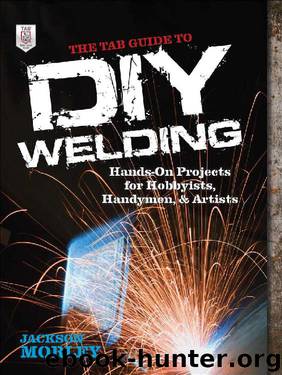The TAB Guide to DIY Welding : Hands-on Projects for Hobbyists, Handymen, and Artists by Jackson Morley

Author:Jackson Morley [Morley, Jackson]
Language: eng
Format: epub
Publisher: McGraw-Hill/TAB Electronics
Published: 2013-04-23T03:00:00+00:00
FIGURE 9.1 Oxy-acetylene cutting in process.
Today, the main reason to use a torch setup is its versatility and cost. If you wanted to outfit a shop to weld, cut, and heat different metals, you’d be looking at spending tens of thousands of dollars. For less than $300 (plus gases), you can buy a torch kit that will do all that. Maybe it’s the Luddite in me, but I think that there is something rewarding about slowing down and enjoying the process that reduces welding to an easy-to-understand process. Also, I really like fire.
Whether you are cutting, welding, or heating steel to bend, the basic principles behind the oxy-acetylene torch are the same. Pressurized gas is let out of each gas cylinder and into a pressure regulator. These regulators not only restrict the flow of gas to a controllable rate known as pound-force per square inch (lbf/in2) but also tell you the pressure of the gas in each cylinder.
When you open the regulators, gas will start to flow through the hoses until it reaches another restriction. The hoses should be connected to the torch head with all valves closed to prevent a gas leak. If when you open the regulator you hear a constant hiss, close the valve and check all knobs on the torch and for leaks along the hose.
For each application of your torch, you will adjust the regulators to a different pressure. Recommended pressure settings will be given in the practice sessions of this chapter. When this pressure reaches the torch head, you must allow it to enter the torch and continue through the tip. There you have another adjustment. Each of the knobs on the torch controls the flow of oxygen or acetylene to the tip of the torch. If you were to burn acetylene alone, it would burn at around 4,000°F and create a lot of soot, and as you learned earlier, oxygen is not flammable by itself. It’s the mixing of these two gases that creates a flame that is over 6,000°F hot, more than hot enough to melt steel.
Before you are ready to weld, cut, or heat steel, you must carefully calibrate the hose pressure and each of the control knobs on the torch to the proper setting for your torch tip and material. This takes some practice, especially when you are wearing insulated gloves, so be patient. The pressure at the regulator is really not how much gas pressure you want at the tip of the torch but rather slightly more than that so that you are never “starved” for gas at the end of the torch. If you were to let the full amount of gas escape from the torch tip, the pressure most likely would extinguish the flame. (This is not the case for torch cutting, when you actually do want the full blast of oxygen to blow the molten steel out of the way.)
By replacing the torch head and tips, you can drastically change the function of the oxy-acetylene setup.
Download
This site does not store any files on its server. We only index and link to content provided by other sites. Please contact the content providers to delete copyright contents if any and email us, we'll remove relevant links or contents immediately.
| Automotive | Engineering |
| Transportation |
Whiskies Galore by Ian Buxton(40299)
Introduction to Aircraft Design (Cambridge Aerospace Series) by John P. Fielding(32331)
Small Unmanned Fixed-wing Aircraft Design by Andrew J. Keane Andras Sobester James P. Scanlan & András Sóbester & James P. Scanlan(32136)
Craft Beer for the Homebrewer by Michael Agnew(17439)
Turbulence by E. J. Noyes(7032)
The Complete Stick Figure Physics Tutorials by Allen Sarah(6631)
Kaplan MCAT General Chemistry Review by Kaplan(6044)
The Thirst by Nesbo Jo(5778)
Bad Blood by John Carreyrou(5762)
Learning SQL by Alan Beaulieu(5399)
Weapons of Math Destruction by Cathy O'Neil(5031)
Man-made Catastrophes and Risk Information Concealment by Dmitry Chernov & Didier Sornette(4728)
iGen by Jean M. Twenge(4694)
Digital Minimalism by Cal Newport;(4511)
Life 3.0: Being Human in the Age of Artificial Intelligence by Tegmark Max(4494)
Audition by Ryu Murakami(4091)
1,001 ASVAB Practice Questions For Dummies by Powers Rod(4034)
Electronic Devices & Circuits by Jacob Millman & Christos C. Halkias(4021)
Pale Blue Dot by Carl Sagan(3996)
